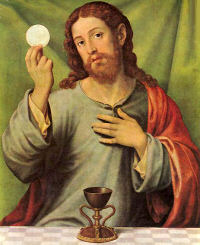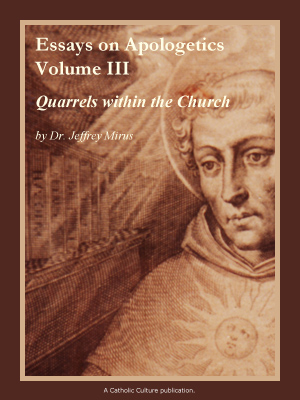Ordinary Time: June 11th
Solemnity of the Most Holy Body and Blood of Christ
Other Titles: Corpus Christi
» Enjoy our Liturgical Seasons series of e-books!
"While they were eating, he took bread, said the blessing, broke it, gave it to them, and said, 'Take it; this is my body.' Then he took a cup, gave thanks, and gave it to them, and they all drank from it. He said to them, 'This is my blood of the covenant, which will be shed for many.'"
The Solemnity of the Body and Blood of Christ is observed on the Thursday following on the Solemnity of the Most Blessed Trinity. Where the Solemnity of the Body and Blood of Christ is not observed as a Holy Day of obligation on Thursday, it is assigned to the Sunday after Trinity Sunday, which is then considered its proper day in the calendar.
The Mass includes an option of singing or reciting the Sequence Laud, O Zion or Lauda Sion before the Alleluia. This sequence is optional. There are only two other feasts (Easter and Pentecost) with Sequences.
This feast is both a doctrinal and cultic response to heretical teaching on the mystery of the real presence of Christ in the Eucharist, and the apogee of an ardent devotional movement concentrated on the Sacrament of the Altar. It was extended to the entire Latin Church by Urban IV in 1264 —Dir. on Popular Piety & the Liturgy, 160).
Please see Catholic Culture's special section on The Solemnity of Corpus Christi.
The Memorial of St. Barnabas, Apostle, which is ordinarily celebrated today, is superseded by the Sunday liturgy.
Commentary on the Sunday Mass Readings for the Solemnity of Corpus Christi, Year A:
The First Reading is from Deuteronomy 8:2-3; 14-16. The Chosen People's journey from Egypt to Palestine, led through the vast desert of Sinai, an expanse of wilderness without food or water. God provided for them a special food which fell around their encampments every evening—a food that has ever since been called "manna," expressing the wonderment of the Israelites when they first saw it. This food, as well as water which burst forth from the rocks at the command of Moses, nourished and sustained them during their forty years' journeying in the desert until they eventually reached the Promised Land.
That this "manna," this miraculous food from the skies, was a symbol, a foreshadowing, of the more miraculous food from heaven which our divine Lord was to give to us to sustain and nourish us spiritually on our journey toward our eternal promised land, hardly needs emphasizing. Our Lord himself refers to the "manna" given by God to their ancestors in the desert but says that he will them the true bread from heaven (Jn 6:31ff).
The Second Reading is from 1 Cor 10:16-17. St. Paul has much to say about the Blessed Eucharist in this first Epistle to the Corinthians. In these two verses he shares how Christian take part in the real sacrifice of the body and blood of Christ and are therefore in communion with God. The feast of Corpus Christi or the Body of Christ is a commemoration or calling to mind of that extraordinary act of love for us which our Divine Lord performed on the night before he died. Through his divine power he left to his Church, to his followers, the power to re-present again and again the sacrifice of his human nature which he was about to offer to the Father next day on the cross for the salvation and elevation of mankind.
The Gospel from John 6:51-58:, from Jesus' discourse on the Bread of Life. This section refers directly to the fact that Christ's human body—his "flesh" and "blood"—would be the sacrificial victim that would win eternal life for men and at the same time as a sacrament it would be their heavenly food and drink. Not only the incredulous Jews, but even many of his disciples drew back and no longer went about with him. Jesus said to the twelve: Will you too go away? Simon Peter answered him, "Lord to whom shall we go? You have the words of eternal life."
Corpus Christi Sunday
Corpus Christi (Body and Blood of Christ) is a Eucharistic solemnity, or better, the solemn commemoration of the institution of that sacrament. It is, moreover, the Church's official act of homage and gratitude to Christ, who by instituting the Holy Eucharist gave to the Church her greatest treasure. Holy Thursday, assuredly, marks the anniversary of the institution, but the commemoration of the Lord's passion that very night suppresses the rejoicing proper to the occasion. Today's observance, therefore, accents the joyous aspect of Holy Thursday.
The Mass and the Office for the feast was edited or composed by St. Thomas Aquinas upon the request of Pope Urban IV in the year 1264. It is unquestionably a classic piece of liturgical work, wholly in accord with the best liturgical traditions. . . It is a perfect work of art.
—Excerpted from The Church's Year of Grace, Pius Parsch
In the words of St. Thomas:
"How inestimable a dignity, beloved brethren, divine bounty has bestowed upon us Christians from the treasury of its infinite goodness! For there neither is nor ever has been a people to whom the gods were so nigh as our Lord and God is nigh unto us.
"Desirous that we be made partakers of His divinity, the only-begotten Son of God has taken to Himself our nature so that having become man, He would be enabled to make men gods. Whatever He assumed of our nature He wrought unto our salvation. For on the altar of the Cross He immolated to the Father His own Body as victim for our reconciliation and shed His blood both for our ransom and for our regeneration. Moreover, in order that a remembrance of so great benefits may always be with us, He has left us His Body as food and His Blood as drink under appearances of bread and wine.
"O banquet most precious! O banquet most admirable! O banquet overflowing with every spiritual delicacy! Can anything be more excellent than this repast, in which not the flesh of goats and heifers, as of old, but Christ the true God is given us for nourishment? What more wondrous than this holy sacrament! In it bread and wine are changed substantially, and under the appearance of a little bread and wine is had Christ Jesus, God and perfect Man. In this sacrament sins are purged away, virtues are increased, the soul is satiated with an abundance of every spiritual gift. No other sacrament is so beneficial. Since it was instituted unto the salvation of all, it is offered by Holy Church for the living and for the dead, that all may share in its treasures.
"My dearly beloved, is it not beyond human power to express the ineffable delicacy of this sacrament in which spiritual sweetness is tasted in its very source, in which is brought to mind the remembrance of that all-excelling charity which Christ showed in His sacred passion? Surely it was to impress more profoundly upon the hearts of the faithful the immensity of this charity that our loving Savior instituted this sacrament at the last supper when, having celebrated the Pasch with His disciples. He was about to leave the world and return to the Father. It was to serve as an unending remembrance of His passion, as the fulfillment of ancient types — this the greatest of His miracles. To those who sorrow over His departure He has given a unique solace."
Symbols and Representation: The usual symbol for the Holy Eucharist is a chalice, with a host rising out of it.
The chalice is shown with a hexagonal base, as a rule, symbolizing the Six Attributes of the Deity (power, wisdom, majesty, mercy, justice and love), and with a richly wrought stem of gold, studded with precious stones. The host is shown as the typical circular wafer, upon which may be imprinted the letters I. N. R. I. or I.H.S., from which proceed rays of light, symbolical of the Real Presence, the substantial presence of Christ under the species of bread and wine.
An altar, upon which is set a cross, two or more candles in their tall candlesticks, a chalice and a ciborium, is another symbol often seen.
Highlights and Things to Do:
- The Directory on Popular Piety explains Eucharistic devotion and Eucharistic adoration.
- Encourage your pastor to have a Eucharist Procession on the Feast of Corpus Christi.
- Freshly baked bread would be a key dish at your celebratory Sunday dinner, as bread has always been symbolic for life giving and nourishment, as is the Eucharist. We have also highlighted a Christmas cookie recipe called Lebkuchen (life cake), which is rich in symbolism.
- Two newer church documents to read:
- The fourteenth encyclical letter of Pope St. John Paul II Ecclesia de Eucharistia (On the Eucharist in Its Relationship to the Church) released on Holy Thursday, April 17, 2003. The focus of the papal encyclical is the celebration of the Eucharist; the Pope reminds us that the Eucharist is the center of Catholic spiritual life.
- Redemptionis Sacramentum (On certain matters to be observed or to be avoided regarding the Most Holy Eucharist), an Instruction released by the Congregation for Divine Worship and the Discipline of the Sacraments on March 25, 2004.






